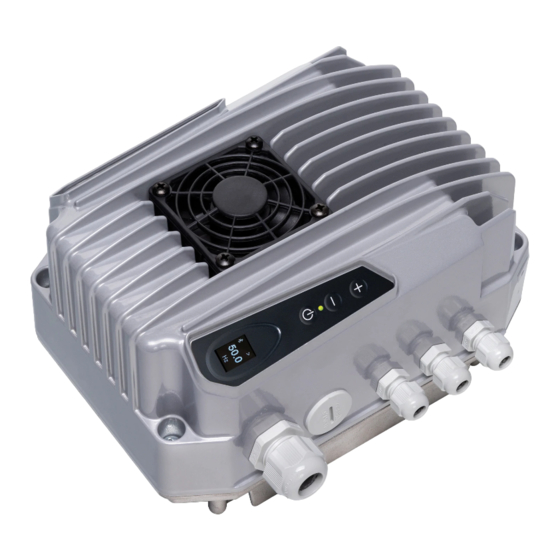
Table of Contents
Advertisement
Advertisement
Table of Contents

Summarization of Contents
Introduction
Purpose of the manual
Explains the manual's objective and provides safety information.
Product overview
Describes the MIDA device's function and benefits for pumping systems.
Safety
Symbols
Explains the meaning of various symbols used in the manual (Tip, Note, Caution, Warning, Danger).
Qualified personnel
Specifies requirements for personnel involved in installation, use, and maintenance.
Safety warnings
Provides general safety precautions for installation and use in different environments.
Acoustic emission
Details the device's acoustic emission level.
Certifications
Lists the product's certifications.
Maintenance
Maintenance
Outlines the required maintenance tasks and their intervals.
Warranty
Explains the warranty terms, conditions, and voiding factors.
Product registration
Describes the process and benefits of registering the product.
Spare parts
Advises on the use of original spare parts and how to obtain them.
Disassembly and repair
Provides guidelines and safety precautions for disassembling and repairing the device.
Disposal
Instructs on the proper disposal methods for the device.
Transport and storage
Transport
Details precautions for transporting the product, including environmental conditions.
Inspection on delivery
Describes checks to perform upon receiving the product.
Handling
Provides instructions and safety advice for handling the product.
Storage
Specifies conditions and duration for storing the product.
Technical features
Name
Explains the naming convention for MIDA products.
Technical Data
Lists electrical specifications for various MIDA models.
General electrical specifications
Lists general electrical parameters like frequency, voltage unbalance, etc.
Environmental specifications
Details environmental operating conditions for the device.
Mechanical specifications
Lists mechanical properties like protection rating and vibration resistance.
Dimensions and weight
Provides physical dimensions and weight for different MIDA sizes.
Cables entry
Details cable gland specifications, tightening torque, and cable diameters.
Mechanical installation
Installation environment
Specifies suitable installation environments and restrictions.
Cooling
Explains the cooling mechanism and required clearance for heat dissipation.
Mechanical assembly of size 2 devices
Details the process for assembling size 2 devices.
Assembly on-board the motor
Guides on how to mount the device directly onto a motor.
On-board motor installation for size 1 devices
Illustrates the process of installing size 1 devices on a motor.
On-board motor installation for size 2 devices
Illustrates the process of installing size 2 devices on a motor.
Wall installation
Explains how to perform wall mounting using an optional bracket.
Wall installation for size 1 devices
Shows diagrams for wall installation of size 1 devices.
Wall installation for size 2 devices
Shows diagrams for wall installation of size 2 devices.
Electrical installation
Grounding
Covers grounding requirements, cable cross-sections, and leakage currents.
Protection devices
Recommends protection devices like circuit breakers and fuses for the device.
Connecting cables
Details cable requirements, tightening torques, and cable types.
Power cables
Specifies cross-sections and tightening torques for power cables.
Control cables
Details specifications for control cables, including shielding and lugs.
Electromagnetic Compatibility (EMC)
Explains EMC requirements and best practices for installation.
Power connections
Illustrates power connection diagrams for specific MIDA models.
Control connections
Details control connection terminals and functions for size 1 devices.
Control connections for size 2 devices
Details control connection terminals and functions for size 2 devices.
Commissioning
Preliminary checks
Lists electrical and mechanical checks before powering up the device.
Powering
Provides instructions and safety warnings for powering up the device.
Use and programming
Keyboard Operation
Explains the functions of the buttons and LEDs on the device's keypad.
Control via App
Details how to control the device remotely using a smartphone application.
Initial Display and Status
Shows the information displayed upon device startup and its meaning.
FOC Motor Control
Explains the benefits and applications of FOC motor control.
FOC Control Calibration
Outlines the steps for calibrating the FOC motor control.
Adjusting FOC Control
Discusses adjusting FOC dynamics based on system configuration.
Menu Navigation
Lists menu structure, descriptions, levels, and default passwords.
Control Parameters
Describes available control parameters and their settings.
Control Mode Settings
Describes different control modes available for the device.
Auxiliary Control Mode
Explains the auxiliary control mode switching function.
Motor Parameters
Covers key motor settings like type, current, frequency, and FOC parameters.
Input/Output Configuration
Covers sensor scaling, digital inputs, and other I/O settings.
Connectivity Settings
Covers MODBUS address, baud rate, and data format settings.
Constant pressure operation
Introduction
Explains how MIDA maintains constant pressure based on demand.
The pressure vessel
Discusses the role and selection of pressure vessels in the system.
Electrical connections
Details electrical connections for pressure sensors.
Splitting the pumping system
Introduction
Explains the benefits of splitting pumping units for efficiency and reliability.
Variable speed pumping unit with two or more pumps in COMBO mode
Describes the COMBO mode for multi-pump operation.
Cascade operating principle
Explains the default cascade operation in COMBO mode.
Synchronous operating principle
Details the synchronous operation mode for energy savings in COMBO.
Electrical connections
Illustrates electrical connections for COMBO mode.
Programming the master unit
Guides on programming the master unit in a COMBO system.
Programming of slave units
Guides on programming slave units in a COMBO system.
Automatic master replacement
Explains the process for automatic master unit changeover.
Operation at constant differential pressure
Introduction
Explains how MIDA maintains constant differential pressure.
Electrical connections
Details electrical connections for differential pressure sensing.
Programming
Outlines parameters for setting constant differential pressure control.






Need help?
Do you have a question about the MIDA 409 and is the answer not in the manual?
Questions and answers